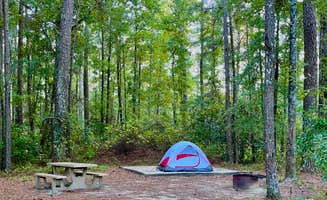Tent camping near Sumter, South Carolina centers primarily around Congaree National Park, which contains approximately 26,000 acres of old-growth bottomland hardwood forest with trees reaching heights of 130 feet. The region sits at approximately 100-200 feet above sea level, creating a flood-prone ecosystem that experiences seasonal inundation. Camping options in the area require preparation for high humidity levels, particularly during summer months when temperatures regularly exceed 90°F.
What to do
Wildlife observation opportunities: At Longleaf Campground, campers report diverse wildlife sightings throughout the seasons. "We saw other wildlife around the campground too. A lizard during a walk during the day. Many frogs during the rain at night," notes Veronica S., highlighting the natural encounters possible near camp.
Paddling excursions: The Congaree River provides waterway access near the camping areas, allowing for exploration of the park from a different perspective. While planning your route, consider that some sections require portage during low water periods. "This spot was one of many on a fall paddling vacation," mentions Sarah C. about her trip near Longleaf Campground.
Educational programs: Carolina Sandhills National Wildlife Refuge offers structured environmental education for groups. "For the purpose of environmental education programs and research activity, school groups and youth groups are welcome to visit the preserve for ranger led programs and can stay overnight at special rustic group campsites," explains Janet R., detailing the service-learning requirements.
What campers like
Night sky viewing: The limited light pollution around Congaree creates excellent conditions for stargazing and experiencing natural nocturnal phenomena. "The fireflies were very pretty and interesting," shares Veronica S. about her stay at Longleaf Campground, highlighting the seasonal synchronous firefly displays that attract visitors.
Peaceful environment: The campgrounds offer significant quiet compared to more developed areas. "After losing several nights of sleep at our previous campground, this one was a huge relief. Sites were spread out, but also the vibe was less 'party all night' and more 'sleep and then explore the park during the day,'" reports Veronica S.
Ancient forest ecosystem: The trails provide access to rare old-growth forest specimens. "Pristine, but organized trails near the Consgree river and Swamp. Lots of wildlife and ancient trees on the trails... A rare treat to go back in time like this," describes J Terrell M. about exploring from Longleaf Campground.
What you should know
Site accessibility: Walk-in requirements at Longleaf vary by site location. "Sites 1-3 are the easiest to get to. We were at site 7, it took about 250 steps from the parking lot to our site," explains kelly about her experience at Longleaf Campground. Consider bringing equipment transport tools for farther sites.
Insect preparedness: The wetland ecosystem supports significant insect populations throughout warm months. "Definitely bring a wagon for packing your stuff in and prepare to be eaten alive by deer flies everywhere you go!" warns Jacinda S. from Blythewood Acres, emphasizing proper insect protection.
Weather impacts: Rainfall can substantially affect camping conditions due to the low-lying terrain. "The first night got a lot of rain and storms and several of the campers from sites farther back left saying they were flooded out," reports Veronica S., highlighting potential flooding risks even when tent pads remain dry.
Tips for camping with families
Site selection strategy: For families with young children or significant gear, prioritize sites closer to parking areas. "If you don't want to walk far, get campsite #1. It's right next to the parking lot and closest to the bathrooms," advises Jacinda S. about Longleaf Campground arrangement.
Gear transport planning: Consider equipment to assist with moving camping supplies from parking to sites. "It would be nice to have a second person or a wagon," suggests Allissa F. from Bluff Hike In Campground, noting the benefits of transport assistance even for shorter walks.
Supply availability: Limited on-site resources means advance planning for necessities. "There is a convenience store with sandwiches, ice, beer, and groceries in Gadsden 8 min away which was convenient," notes Allissa F., identifying nearby resupply options for extended stays.
Tips from RVers
Level site availability: For RV travelers passing through, confirm site dimensions and leveling requirements before arrival. "Water, sewer, power and dump station on site! These sites are level and waiting for your RV," reports Ashley F. about Carolina Sandhills National Wildlife Refuge, noting the practical setup for self-contained vehicles.
Hookup configurations: RV sites vary in available utility connections throughout the region. Most tent-focused areas lack hookups, while designated RV areas typically provide electric, water, and sometimes sewer. "About 300 feet from the parking lot so easy to walk into and make trips back to the car or motorcycle in my case," explains J P., describing the vehicle-to-site relationship at Longleaf Campground.
Seasonal access limitations: Weather patterns affect road conditions and site availability for larger vehicles. "It's lowlands so it floods easily in heavy rains...learned this the hard way!" cautions J P., highlighting the need for contingency plans during wet seasons.


